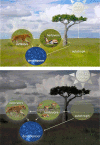Synthetic biology meets bioprinting: enabling technologies for humans on Mars (and Earth)
- PMID: 27528764
- PMCID: PMC4984444
- DOI: 10.1042/BST20160067
Synthetic biology meets bioprinting: enabling technologies for humans on Mars (and Earth)
Abstract
Human exploration off planet is severely limited by the cost of launching materials into space and by re-supply. Thus materials brought from Earth must be light, stable and reliable at destination. Using traditional approaches, a lunar or Mars base would require either transporting a hefty store of metals or heavy manufacturing equipment and construction materials for in situ extraction; both would severely limit any other mission objectives. Long-term human space presence requires periodic replenishment, adding a massive cost overhead. Even robotic missions often sacrifice science goals for heavy radiation and thermal protection. Biology has the potential to solve these problems because life can replicate and repair itself, and perform a wide variety of chemical reactions including making food, fuel and materials. Synthetic biology enhances and expands life's evolved repertoire. Using organisms as feedstock, additive manufacturing through bioprinting will make possible the dream of producing bespoke tools, food, smart fabrics and even replacement organs on demand. This new approach and the resulting novel products will enable human exploration and settlement on Mars, while providing new manufacturing approaches for life on Earth.
Keywords: applied microbiology; biological materials; human exploration; synthetic biology.
© 2016 The Author(s).
Figures




References
-
- Reference deleted. - PubMed
-
- Lepore E., Bonaccorso F., Bruna M., Bosia F., Taioli S., Garberoglio G., Ferrari A., Pugno N.M. Silk reinforced with graphene or carbon nanotubes spun by spiders. arXiv preprint arXiv. 2015:150406751.
-
- Davila A.F., Wilson D., Coates J.D., McKay C.P. Perchlorate on Mars: a chemical hazard and a resource for humans. Int. J. Astrobiol. 2013;12:321–325. doi: 10.1017/S1473550413000189. - DOI
MeSH terms
Substances
LinkOut - more resources
Full Text Sources
Other Literature Sources
Miscellaneous

